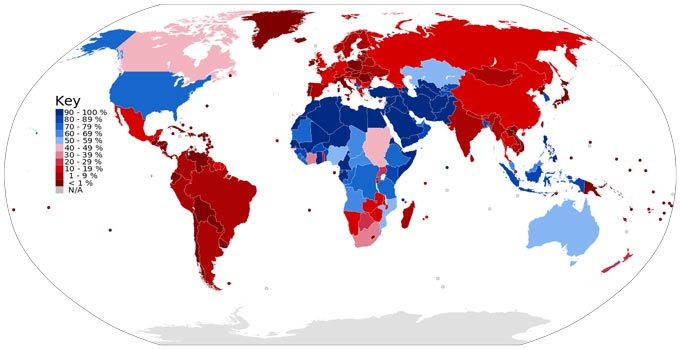
Scientific Evidences
Epidemiological evidence points to the inner surface of the foreskin, which contains Langerhans’ cells that act as HIV receptors – a likely point of entry for uncircumcised men. A keratinized stratified squamous (scaly) epthelium (membranous tissue) covers the penile shaft and outer surface of the foreskin. This provides a protective barrier against HIV infection.
The inner mucosal (mucus) surface of the foreskin isn’t keratinized and is rich in Langerhans’ cells. During intimate relations, the whole inner surface of the foreskin touches vaginal secretions. Thus, it provides more area for HIV transmission.
Forty studies provide evidence that male circumcision protects against all sexually transmitted diseases. Circumcised men are also 2-8 times less likely to become infected.
Robert Szabo concludes that circumcision, as Islam teaches, would be the most immediately effective intervention for reducing HIV transmission since it occurs before men are sexually active (Szabo, p1-3).
Epidemiologist Robert Baily of the University of Illinois, Chicago, said, “No one wants to be the first to come out with a statement in support of male circumcision.” In the US and Europe, there are big anti-circumcision movements now, so people don’t want to promote something in Africa that is discouraged here…” (Shillinger, p.2).
Circumcised men come from communities that place a deep religio-cultural significance on this particular hygiene practice; which doesn’t necessarily apply to those who do not (Shillinger, p.1). The majority of Muslims believe that male circumcision is obligatory. It’s one of the five acts of cleanliness in Sahih Muslim, Sahih Bukhari, Musnad Ahmed and Sunnah at-Tirmidhi (Persaud, p.1).
There are also additional obligations of hygiene and social conduct within marriage. However, this doesn’t mean that Muslims are immune to AIDS. That’s since Islamic practices have become compromised by other factors. About 50% of Moroccan women who have AIDS have been infected by their husbands (Clinton, p.3).
For now at least, the safest path to follow is one of cleanliness and purity, which modern science has confirmed. At the center of the hypothesis that male circumcision does provide a measure of protection against HIV-AIDS are puzzling discrepancies in HIV prevalence between different countries and regions, despite the presence of what seems to be similar risk factors.
For example, rates of HIV infection continue to be much lower in Asia’s Philippines (0.06 percent of the adult population), Bangladesh (0.03 percent) and Indonesia (0·05 percent), compared to Thailand (2.2 percent), India (0.8 percent), and Cambodia (2.4 percent).
Infection rates are also much lower in Africa’s Nigeria (4.12 percent), Ghana (2.38 percent) and Kenya (11.64 percent), compared to Namibia (19.94 percent), Botswana (25.10 percent) and Zimbabwe (25.84 percent).
It is this startling disparity between West and Southern Africa that has led researchers to conclude that the missing link is because unlike in Southern Africa, in much of West Africa circumcision is an ingrained cultural and traditional practice that has worked to keep HIV at bay.
There is no disagreement on the fact that AIDS spreads through sexual intercourse. The argument centers around protection men reportedly derive from the removal of the foreskin, to the extent that circumcision reduces infection by up to 50 percent.

Global map of Male Circumcision Prevalence
Accelerating Researching
Over 45 studies have examined the link between HIV and circumcision. Pro-circumcision researchers argue that the skin on the inside of the male foreskin is “mucosal”, similar to the skin found on the inside of the mouth or nose.
This mucosal skin reportedly has a high number of Langerhan cells, which are HIV target cells rich in white blood cells or doorway cells for HIV.
“HIV looks for target cells like the Langerhans; it’s a lock and key,” Edward G. Green, senior researcher at Harvard University told The Washington Times. “The rest of the skin on the penis is armor-like.”
Dr. Jimmy Gazi, who is acting-president of the Zimbabwe Red Cross Society and also chairman of the Southern Africa Development Community (SADC) AIDS Scaling Committee, says that due to the “moist, mucosal surface” on his penis, “the uncircumcised male has a much higher chance of having a micro laceration in the glands and inside the foreskin than the circumcised male.” This exposes him to a greater risk of getting sexually transmitted diseases and HIV.
However, Gazi says that although circumcision is a good practice for those who subscribe to it, he would not put it as a major factor in hindering the transmission of HIV-AIDS.
It is now several decades since the first study on the increased risk of HIV infection among uncircumcised men was published. Since then, there were at least 45 scientific inquires to examine the link between HIV and circumcision.
One of the earlier investigations on the issue is a comparative study of four African cities conducted by UNAIDS in 1999. Two West African cities, Cotonou in Benin, and Yaounde the capital of Cameroon, had low HIV infection rates of three percent and four percent respectively among men aged 15-49.
The other two sites, Kisumu, Kenya, and Ndola in Zambia, had infection rates of 20 percent and 23 percent respectively for the same population group. In Cotonou and Yaounde, nearly all men in the study had circumcision. Only 10 percent of the men in Ndola and less than 30 percent of the men in Kisumu, meanwhile, had undergone the procedure.
Furthermore, the study found, ”HIV prevalence was below eight percent in men circumcised before their sexual debut and 25 percent in uncircumcised men.”
Despite studies like this, the medical body is still divided on the preventative benefits male circumcision might have. One thing that some anti-circumcision researchers point out is why the United States has the highest rate of HIV infection amongst Western countries while the great majority of the male population in the United States is circumcised.
Potentially, however, a pro-circumcision verdict within the medical community would allow for a relatively cost-effective mass circumcision campaign in much of resource-strapped Southern Africa where, according to the International Federation of the Red Cross and Red Crescent Societies, “a gradual slide into destitution is underway which triggers further spread of HIV and ever-greater vulnerability to common disease and disaster.”
Pages: 1 2 3

